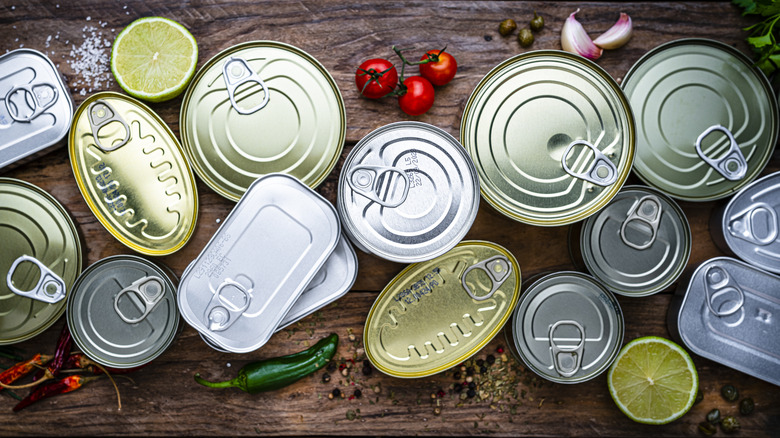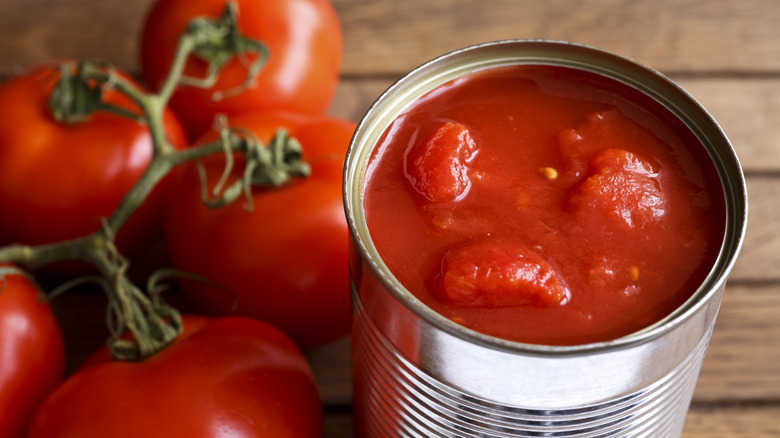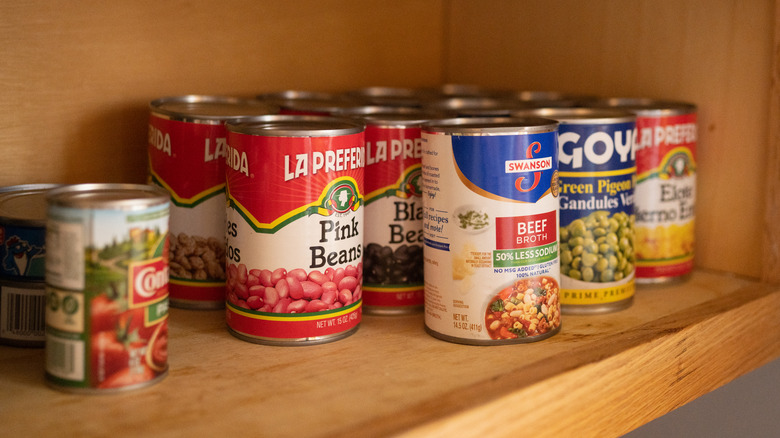How Acidity Affects The Shelf Life Of Canned Foods
Using metal containers to preserve foods dates back to the early 19th century. Even today, it is one of the best ways to ensure food has a longer shelf life without the need for refrigeration or freezing. Keeping a good stock means you can live off nothing but the food in your pantry for weeks, without the need for regular shopping trips. But you've probably noticed that some canned foods last longer than others. And if you've ever wondered why, it partly comes down to how acidic they are.
Usually, acid is a good thing when it comes to preserving foods, helping them to last longer. That's because acid helps to prevent the growth of bacteria, which causes food to go off. And sometimes, acid is even used as an additional preservative when it comes to the canning process. But in fact, acidity has an impact on longevity once the produce is canned.
Canning works by preserving foods in a vacuum-sealed and airtight container, which is heat processed at 250 degrees Fahrenheit to destroy bacteria, fungi, and other microorganisms, and to stop any new ones from entering. But high-acid foods, such as canned tomatoes, actually deteriorate faster than low-acid foods. It's all to do with how the contents react with the container itself, which causes an electrochemical reaction. This can make the can's lining corrode over time.
High-acid foods cause can corrosion and deteriorate faster
The reason why canned goods deteriorate comes down to a process called internal corrosion, according to a 1982 research article published in the "Journal of Critical Reviews in Food Science and Nutrition." This causes metallic dissolution, where the food within the can reacts with the metal from which it is made.
If the contents have high acidity, this process of dissolution happens faster, which in turn makes the shelf life of the product significantly shorter. And while it's not the same as food spoiling in the usual sense, this chemical reaction can alter the texture, color, and flavor of the contents, as well as affect its nutritional value over time. In short, it will make what is inside the container pretty unpleasant to eat.
As for what types of food are classed as high-acid, it's items such as tomatoes and other fruits and juices, as well as pickled produce. This gives them a shorter shelf life of around 18 months (via USDA). Low-acid foods such as canned soups (which can be used in lots of delicious ways), meats, beans, or vegetables may last for much longer: anywhere between two and five years, depending on the item. Home canned goods are the exception as they are prepared under different conditions to those in commercial manufacturing; these should be used within 12 months.
How to store canned food so it lasts longer
Often with canned food, the date refers to the quality of the contents, which deteriorates over time, rather than it actually going off — rather like the difference between sell-by dates and use-by dates. Even so, you shouldn't buy any cans that are bulging, have dents in them, are leaking any of their contents, or look rusted, as they could let bacteria in. In the case of bulging cans, or ones that smell foul or spurt liquid upon opening, it could even be a sign of potential botulism infection though this is extremely rare; carefully dispose of any that show these signs — and don't recycle the cans.
Once you've purchased canned food, to keep it in the best possible condition, it's important to store it correctly once you get it home. A cool, dry place is the best environment, ideally at a temperature below 85 degrees Fahrenheit (via USDA). But not too cold — you should never eat canned food that was accidentally frozen because the expanding water can damage the structure of the can and compromise its contents.
If you want to keep any unused food once you've opened a can, transfer it to a plastic or glass container and keep it in the refrigerator; this will keep it tasting better for longer. High-acid foods will keep for around five to seven days in the fridge once they've been opened; for low-acid foods, aim for three to four days.



